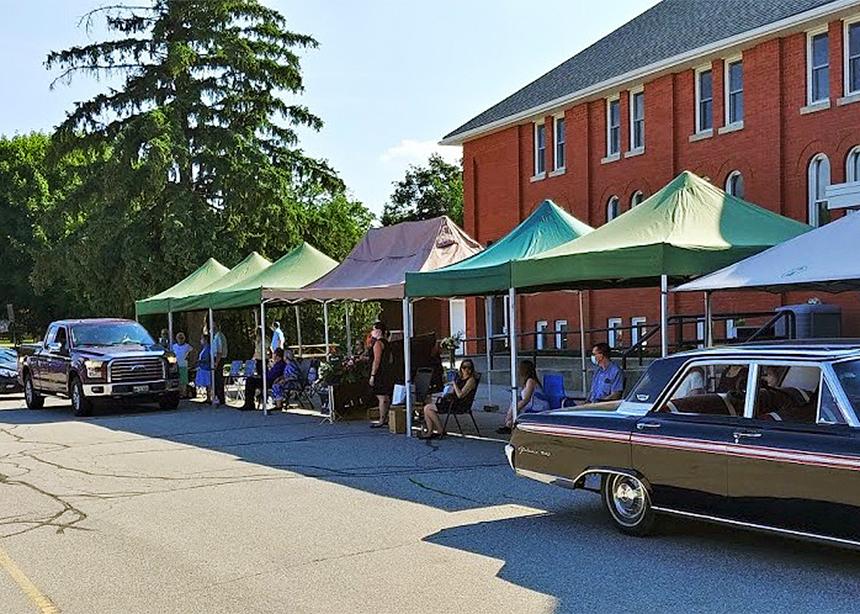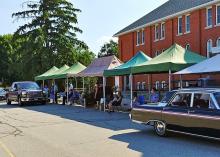Amid the restrictions of COVID-19, pastors and families are still finding creative and meaningful ways to mark, grieve and ritualize the deaths of loved ones. But no two funerals are the same, and there are added stressors, frustrations and disappointments.
Mark Diller Harder, pastor of St. Jacobs (Ont.) Mennonite Church, where there have been four funerals since early April, says, “There are no models for this.”
So Mennonite Church Eastern Canada leaders sought guidance from local funeral directors, who, in turn, consulted with their colleagues across the province, in order to provide clear advice about how to abide by provincial regulations that changed over time.
Pastors give credit to funeral directors for their excellent work in guiding families through the COVID-19 regulations and safety protocols with sensitivity. They also consult with each other and praise the tech providers in their churches for supporting new ways of projecting, recording and sharing family meetings and funeral services.
For Anita Schroeder Kipfer, pastor of Floradale (Ont.) Mennonite Church, who helped to lead a funeral recently, it was about “meeting the needs of the family,” and honouring the person who died “in the best way we could.” She felt it was important to provide family and community members with a model for how a funeral could be done, and assurance that “we will do everything we can to make it something you would have wished for.”
Tanya Dyck Steinmann is a pastor of East Zorra Mennonite Church in Tavistock, Ont., where there have been four funerals so far during this pandemic period, all of them small family services. She has found that “families continue to be respectful of public health guidelines and choose intimate, meaningful, private ways to say goodbye to their loved ones.”
Diller Harder acknowledges that, for families and their loved ones, “the dying process was harder” because no in-person visits were possible, until near the time of death, and even then they were limited. There was “certainly added stress and disappointment,” he says, noting the toll that separation took on families and their loved ones in hospital, or in palliative and long-term care. He appreciates the “graciousness of institutions” to let some family members, and sometimes even a pastor, in at the end.
In the face of COVID-19 restrictions, Diller Harder says, they were “able to mark these deaths, but not in the fullest way they would have liked to.” While the “worship rituals were as rich as they could be, whatever the restrictions at the time,” families certainly missed having people present, and missed the time of food and fellowship.
Wanda Roth Amstutz, who conducted two memorials under COVID-19 restrictions at Cassel Mennonite Church in Tavistock, says one of the hardest parts for her was that the church family “could not have the same opportunity to reflect and grieve and process these two deaths. I think we will still need to do that at some point as a community when we are able to gather together again in a way that might include food.”
Diller Harder says, “There wasn’t a right or wrong way to do this.” There were “good things about how each one was done.” In some cases, services were livestreamed from a funeral home, conducted over Zoom, or recorded at the graveside, allowing people from a great distance to participate. In the first couple of months of pandemic restrictions, when indoor gatherings were limited to five people and graveside burials to 10, pastors and families chose a variety of creative ways to mark the deaths of loved ones.
One family chose to postpone a celebration of life to a later date. They did spend two hours as an extended family on Zoom with pastors for a time of prayer, scripture, music, sharing and storytelling. They recorded the Zoom call to be shared with those who could not attend.
Another family chose a graveside service with nine people, while others joined through an iPad. In addition to the words of committal, the pastor expanded the service to include scripture, prayer, music and a short meditation. Another family chose a similar service, and added family tributes at the graveside.
Some families decided to divide into smaller units for visitation, time to say goodbye with the body of their loved one, and time at the graveside service. Pastors repeated the same graveside service for different family groupings.
Similarly, one family divided into small groups for visitation and a short service, repeated three times for different groupings, in the church foyer.
One family chose a full Zoom funeral, which included both live and recorded music, family tributes, scripture, prayer and a meditation. At the end, the service was opened up for a time for sharing, and they spent another hour listening to tributes and stories from friends and family who joined remotely.
As COVID-19 restrictions eased, other families had more options available to them. One family chose to have a drive-by visitation in the church parking lot, where they set up tents for each family and easels with photo boards. They had an invitation-only service at the funeral home for 40 people, which was live-streamed for those unable to attend. At the service, people wore masks and the music was pre-recorded.
More recently, one funeral was conducted in a church when that became possible. Visitation took place in the foyer, respecting protocols for masks, physical distancing and extra sanitation. From there, the 75 invited attendees filed into the large sanctuary for the funeral service, which was also livestreamed. Some music was pre-recorded. Live music was offered by a quartet that could physically distance from each other and the congregation. On the way out, people received a pre-packaged cookie to eat in the car, as a way to honour a person who loved food and fellowship.
Going forward, Schroeder Kipfer acknowledges that, whenever people gather, there will be risk, especially for seniors, so she emphasizes the importance of respecting safety protocols.
Do you have a story idea about Mennonites in Eastern Canada? Send it to Janet Bauman at ec@canadianmennonite.org.




Add new comment
Canadian Mennonite invites comments and encourages constructive discussion about our content. Actual full names (first and last) are required. Comments are moderated and may be edited. They will not appear online until approved and will be posted during business hours. Some comments may be reproduced in print.